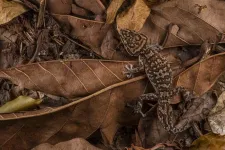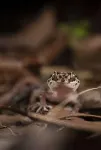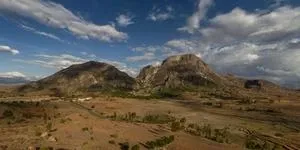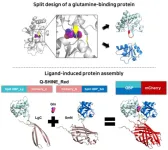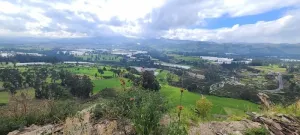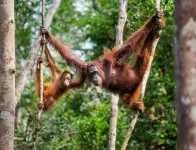Bouldering in south-central Madagascar: a new “rock-climbing” gecko species of the genus Paroedura
2023-10-11
(Press-News.org)
Named after its habitat preference, Paroedura manongavato, from the Malagasy words “manonga” (to climb) and “vato” (rock), is a bouldering expert. Part of its “home range” is also very well-known to rock climbers for its massive granitic domes. “Its description represents another step into the crux (in climbing jargon, the most difficult section of a bouldering problem) of resolving the taxonomy of the recently revised P. bastardi group, where the new species belongs, and reaching a total of 25 described species in this genus, all exclusively living in Madagascar and Comoros,” says C. Piccoli from CIBIO - Research Center in Biodiversity and Genetic Resources, Portugal. She and her team just published a paper describing the new gecko.
Thus far, this species has only been found in Anja Reserve and Tsaranoro, both of which are isolated forest patches in the arid south-central plateau of Madagascar. These sites, at a distance of ca. 25 km, have a peculiar conformation, with huge granitic boulders close to rocky cliffs and surrounded by vegetation. The survival of P. manongavato, defined as microendemic for being restricted to a very narrow distributional range, thus depends on the preservation of these small forest patches. Subsequently, the authors proposed an evaluation of its conservation status as Critically Endangered, a category designated for species threatened of extinction by the International Union for Conservation of Nature.
Its discovery history is long, starting during the Malagasy summer of 2010, when the first evidence of another Paroedura species was found in Anja, together with the recently described P. rennerae in 2021. Distinguishing these two species on the field is a difficult task. Both species have prominent dorsal-enlarged keeled scales and a similar dorsal pattern, although adults of P. manongavato have an overall less spiky appearance, less contrasted dorsal markings, and a smaller body size compared to P. rennerae. The need to collect more samples brought researchers A. Crottini, F. Andreone, and G. M. Rosa to return to Anja in 2014, and collect the future holotype (i.e. the name-bearing and description reference individual) of this new species. Later in 2018, F. Belluardo, J. Lobón-Rovira, and M. Rasoazanany, visited Anja and Tsaranoro again and were able to collect several tissue samples and high-resolution photos of the reptiles living in the area, including the new gecko species. This cumulative data collection was fundamental to advance with its description.
Published in the open access journal ZooKeys, this study highlights the importance of conducting herpetological inventories in Madagascar to improve our understanding of species diversity and progress with species conservation assessments. “The description of this species shows the importance of collaborative efforts when documenting biodiversity, especially for those range-restricted and isolated species at greatest risk of disappearing,” points out the leading author of this study C. Piccoli.
Original source
Piccoli C, Belluardo F, Lobón-Rovira J, Oliveira Alves I, Rasoazanany M, Andreone F, Rosa GM, Crottini A (2023) Another step through the crux: a new microendemic rock-dwelling Paroedura (Squamata, Gekkonidae) from south-central Madagascar. ZooKeys 1181: 125-154. https://doi.org/10.3897/zookeys.1181.108134
Funding information
Fieldwork was funded by National Geographic Society (grant number EC–50656R–18 to FB) and by Portuguese National Funds through Fundação para a Ciência e a Tecnologia (FCT) (grant number PTDC/BIA-EVL/31254/2017 to AC).
Portuguese National Funds through FCT supported the research contract to AC (2020.00823.CEECIND/CP1601/CT0003) and the PhD studentships through the Biodiversity, Genetics & Evolution Doctoral Programme (BIODIV) of CP (SFRH/BD/144342/2019), FB (PD/BD/128493/2017), and JLR (PD/BD/140808/2018). JLR is currently supported by Fundação BIOPOLIS (contract BIOPOLIS 2022-18), co-funded by the project NORTE-01-0246-FEDER-000063 supported by Norte Portugal Regional Operational Programme (NORTE2020), under the PORTUGAL 2020 Partnership Agreement, through the European Regional Development Fund (ERDF).
END
ELSE PRESS RELEASES FROM THIS DATE:
2023-10-11
Predators must eat to survive — and to survive, prey must avoid being eaten. One theory, the Wolf-Mangel model, suggests predators could use false attacks to tire prey out or force them to take bigger risks, but this has been hard to show in practice. Now, scientists observing peregrine falcons have found evidence that they deliberately exhaust their prey to improve later hunting success.
“Although predators are imagined as clever in novels and movies, like the velociraptors in Jurassic Park, empirical biologists are generally not inclined to give much credence to such ideas,” ...
2023-10-11
In 2023, life expectancy in Korea will be 83.6 years, the third highest among OECD countries, and it is steadily increasing every year. As the proportion of the elderly population increases, the social cost of treating various geriatric diseases is also increasing rapidly, and there is a growing interest in early diagnosis of diseases. Among the various diagnostic methods, researchers are actively conducting research on measuring glutamine as an indicator of geriatric diseases by finding that the concentration of glutamine in the cells and blood of patients with serious diseases such as cancer, diabetes, and dementia is significantly changed compared to normal people.
Dr. Seo, Moon-Hyeong ...
2023-10-11
Herbicides are the most used class of pesticides worldwide, with uses in agriculture, homes and industry. Exposures to two of the most popular herbicides were associated with worse brain function among adolescents, according to a study led by researchers at the Herbert Wertheim School of Public Health and Human Longevity Science at University of California San Diego.
In the Oct. 11, 2023 online issue of Environmental Health Perspectives, the researchers reported measuring metabolite concentrations of two commonly used herbicides — glyphosate and 2,4-dichlorophenoxyacetic acid (2,4-D) — and the insect repellent DEET in urine samples ...
2023-10-11
A new antibiotic drug developed by a research team led by Professor Li Xuechen from the Department of Chemistry at The University of Hong Kong (HKU) has recently gained approval from the authorities to undergo clinical trials in the Mainland.
The new drug, which has taken the research team ten years to develop and is named Kynomycin, received the "Notice of Approval for Drug Clinical Trials" from the National Medical Products Administration of China to be tested in human subjects.
The new antibiotic drug targets complex skin and soft tissue infections (cSSTI) caused by bacteria. It ...
2023-10-11
Transition metal dichalcogenide (TMD) semiconductors are special materials that have long fascinated researchers with their unique properties. For one, they are flat, one-atom-thick two-dimensional (2D) materials similar to that of graphene. They are compounds that contain different combinations of the transition metal group (e.g., molybdenum, tungsten) and chalcogen elements (e.g., sulfur, selenium, tellurium).
What's even more fascinating is that assembling different TMD layers into vertical stacks creates a new artificial material called a van der Waals (vdW) heterostructure. By incorporating different materials, it becomes possible to ...
2023-10-11
High-grade serous ovarian carcinoma (HGSOC) is the most common type of ovarian cancer. It is also the most lethal form, in part because clinicians do not have effective ways to screen women for it during the cancer's early stages, when it's easiest to treat.
For patients with a pelvic mass (an abnormal lump or growth in the lower abdomen), it is difficult to detect whether the growth is benign or cancerous ahead of surgery. Unlike many other cancers, biopsies are typically not an option. That makes it hard for doctors to choose the best course of treatment.
Now, a new blood test ...
2023-10-11
University of Queensland research has found despite considerable conservation efforts, the illegal killing of critically endangered orangutans on Borneo may be an ongoing threat to the species.
PhD candidate Emily Massingham from UQ’s Faculty of Science managed a team of researchers which visited 79 villages across the Bornean orangutan range in Kalimantan, conducting face to face interviews with 431 people.
“Our study builds on previous research which indicated killing was one of the key reasons for orangutan population decline, alongside habitat loss,” Ms Massingham said.
“The ...
2023-10-11
Nursing homes that use a chlorhexidine bathing routine to clean the skin, and an over-the-counter antiseptic to clean the nose, prevent serious infections and reduce the amount of antibiotic-resistant organisms in the nursing home setting, according to the findings of researchers at Harbor-UCLA Medical Center, the University of California, Irvine, and the Centers for Disease Control and Prevention (CDC). The findings were published today in the New England Journal of Medicine.
“The ...
2023-10-11
The biological impact of renting, as opposed to owner occupancy, is nearly double that of being out of work vs having paid employment, the findings suggest.
Fortunately, these effects are reversible, emphasising the importance of housing policy in health improvement, say the researchers.
Numerous aspects of housing are associated with physical and mental health, including cold, mould, crowding, injury hazards, stress, and stigma. But exactly how they might exert their effects isn’t entirely clear, say the researchers.
To explore this further, they drew on epigenetic ...
2023-10-11
But the condition is less common in men, even though they are more likely to have the 4 genetic variations implicated in heightened risk, suggesting that there may be sex specific causes, say the researchers.
Most cases of CRPS are usually triggered by an injury, with the skin of the affected body part hypersensitive to the slightest touch or temperature change. CRPS is difficult to treat, and while it often improves with time, some people experience intense pain for many years.
But why some people develop CRPS yet others don’t after the same injury, isn’t clear. ...
LAST 30 PRESS RELEASES:
[Press-News.org] Bouldering in south-central Madagascar: a new “rock-climbing” gecko species of the genus Paroedura
